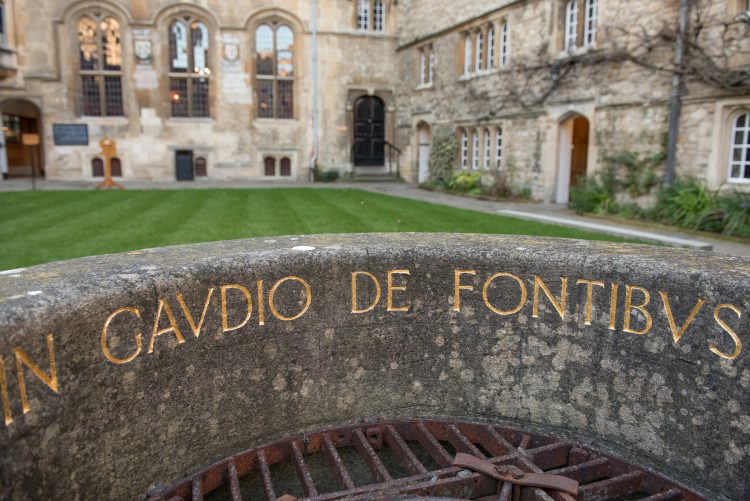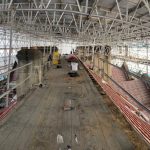New gilding for Teddy Hall’s historic well
20 Feb 2018

The well has long been a focal point in the College’s beautiful Front Quad, but has recently become even more eye-catching thanks to some gilding work on its inscription. This came about through the generosity of Darrell Barnes (1963, Modern Languages), who also had the idea in the first place. Tom Ball of Swan Farm Studios carried out the work for us.
The following words, from Isaiah 12:3, are carved on the well-head: “HAVRIETIS AQVAS IN GAVDIO DE FONTIBVS SALVATORIS” (“With joy, you will draw water from the wells of salvation”). They are among those recorded as spoken by St Edmund of Abingdon on his death-bed. Former St Edmund Hall Principal and historian A.B. Emden observed that: “In this well we may claim a link with St Edmund, for, if we may assume that he once lived in a house on the site of the Hall, then it would have been from this well that he was supplied with water.”
The well has a long and fascinating history, dating back to at least the beginning of the thirteenth century, and would have been the Hall’s source of water until the installation of a main supply in the city. Later on, it fell into disuse and lay hidden for many years, until it was rediscovered during building work in 1927. “In clearing the ground in a corner of that portion of the Quadrangle which was fenced off to form a building yard during the erection of the New Building, some workmen came upon the massive flag-stone with which the mouth of the well had been sealed,” Emden reported in the St Edmund Hall Magazine of 1927. “The removal of the stone revealed a well-shaft built of worked stone, with a drop of about nine feet to the level of the water. On soundings being taken it was found that the water was seven feet deep.”
The well is mentioned in the compotus roll of Oseney Abbey for the 1469-1470, and then reference is made to it a century later, when the buildings of the Hall were being put into repair by the Queen’s College soon after the College had come into possession of the site. “It may be supposed that at this period water was still drawn from the well by windlass and bucket,” wrote Emden. “At a later date, however, two leaden pipes were let down into the well and connected with pumps, the one at the Principal’s Lodging, the other half-way along the building on the north side of the Quadrangle. These two pipes were still found in position when the well was uncovered. The one which connected with the pump at the Principal’s Lodging has been cut away, but the other one has been left and connected with a new pump which is being placed close by the spot where its predecessor stood.”
At the time when the well was rediscovered, plans were already underway to make a path across the Quad in order to connect the old and new buildings, and it was decided to place a stone well-head in the middle of the grass. Apparently there was some discussion about adding some ornamental iron-work over it, containing a pulley for a well bucket, but this was ultimately rejected.
The inscription was carved originally into the stonework on the top of the new wellhead, but worn away over the years. In 1963, the wellhead was restored and the opportunity was taken to carve the inscription in the first course of stonework within it. Over half a century of weathering and growth of lichen made the words difficult to make out, until the recent clean and regild.
Categories
Related News

